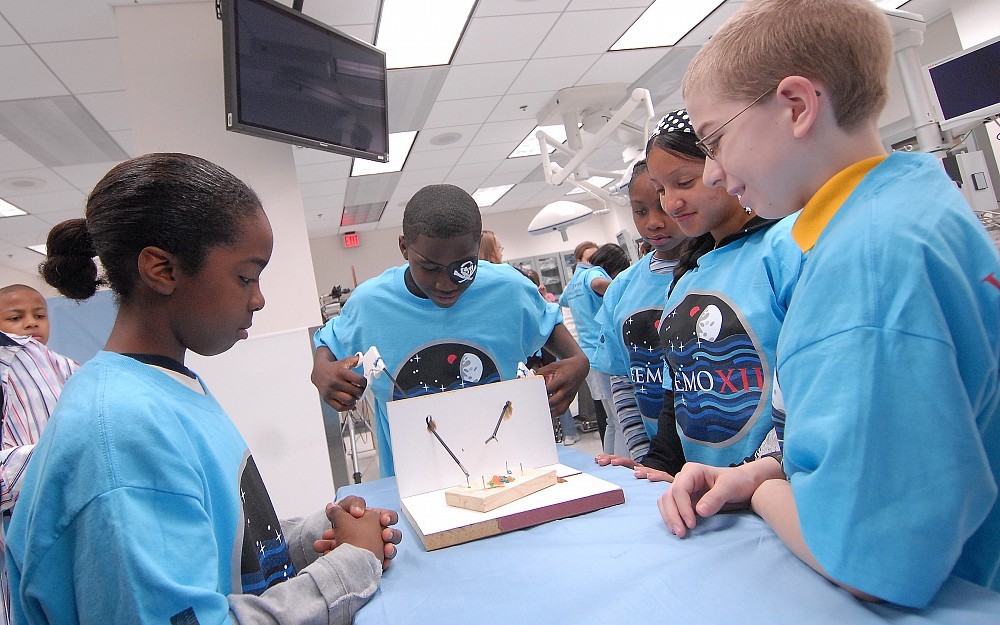
NASA Extreme Environment Mission Teaches Local Students About Space, Robotics and Other Cool Science
CINCINNATILocal junior high students got a hands-on demonstration of just how cool science can be during a robotics competition hosted at the University of Cincinnatis Center for Surgical Innovation. The competition is being conducted in conjunction with the 12th NASA Extreme Environment Mission Operation (NEEMO) to get kids excited about careers in science and medicine.
UC surgeon Timothy Broderick, MD, is part of the undersea mission aimed at improving medical care for future space travelers. A gastrointestinal surgeon, Broderick, became an aquanaut as part of the NEEMO 9 mission in 2006.
The NEEMO 12 crew splashed down Monday, May 7 for 12 days submerged aboard the National Oceanic and Atmospheric Administrations Aquarius Underwater Laboratory off the Florida coast.
The crews goal is to further refine surgical technologies to be used in long space voyages. The aquanauts will test two remotely controlled surgical robots in a variety of advanced medical experiments, including robotic telesurgery on simulated patients.
For the robotics competition, teams of five students from local schoolsSchroder Junior High School, the Indiana School for the Deaf, Taft Elementary and Clark Montessorirotated through four robotic surgery stations designed to test their hand-eye coordination and finesse at manipulating laparoscopic tools.
Students attempted to move rings from one peg to anotherfirst using just laparoscopic graspers, then using the graspers with one eye closed, followed by manipulating hand-controlled robotic arms and finally using the da Vinci robotic surgical system commonly used for clinical care.
Winners of the competition will get to drive a surgical robotcalled the RAVENthat NEEMO 12 scientists are testing in the Aquarius habitatat a community educational program from 4 p.m. to 6 p.m., May 9, at Cincinnati Museum Center.
The same day, during an educational outreach session at 10 a.m., a group of at least 200 local schoolchildren will also talk directly to Broderick and the NASA team about how doctors will eventually treat sick or injured astronauts when they are millions of miles away from the hospital. The children will hear what its like to live and work undersea and have an opportunity to ask questions during a virtual tour of the scientists tiny living space.
Broderick is principal scientist for NEEMO 12, which includes research projects from UC, the National Space Biomedical Research Institute, NASA Johnson Space Centers Space and Life Sciences Directorate, SRI International and the University of Washington.
One UC experiment will test semi-autonomous robots. Unlike todays robotic surgeryin which a surgeon controls every move a robot makesrobotic surgery of the future may use robots that are programmed to perform surgeries on their own.
Broderick and his team will not be to that point during the NEEMO 12 missionbut they will test a surgical robots ability to perform specific important tasks.
One test might involve equipping the surgical arm with a needle and telling it to drain an abscess, explains Broderick. But the surgeon will only supervise, not control, the robotic arm.
He says technology applications developed and refined during the NEEMO 12 mission will help surgeons overcome interplanetary communication lag time and could improve the care of astronauts on future missions to the moon and Mars.
We need to figure out better ways to care for astronauts before we make the long trip to Mars, Broderick says. Telemedicine and robotic surgery could be key in maintaining the health of future spacefarers and responding to medical emergencies in space.
In addition to the telesurgery demonstrations, the crew will conduct simulated undersea "moon walks" to test concepts for future lunar exploration. During these simulated moon walks, they will construct an undersea structure with the help of a remotely operated vehicle, similar to what the next travelers to the moon may do. The crew also will practice collecting geological samples to help develop tools and techniques for collecting lunar samples and training future lunar explorers to be geologists.
More information on the NEEMO initiative is available at www.nasa.gov/neemo.

Students from Schroder Junior High compete in the NEEMO 12 robotics competition at UC.

Tim Broderick, MD, (left) will live under water for 12 days in the National Oceanic and Atmospheric Administration s Aquarius Underwater Laboratory off the Florida coast as a member of the NEEMO 12 crew.
Tags
Related Stories
UC study: Brain organ plays key role in adult neurogenesis
July 2, 2024
The University of Cincinnati has published research in the Proceedings of the National Academy of Sciences that found the choroid plexus and cerebrospinal fluid play a key role in maintaining a pool of newly born neurons to repair the adult brain after injury.
Put down that beer; it's not a tanning lotion
July 1, 2024
The University of Cincinnati's Kelly Dobos joined WVXU's Cincinnati Edition to discuss what's fact and what's myth when it comes to sunscreen use, different kinds of sunscreen and a social media recommendation to use beer on your skin to help get a tan.
Cincinnati researchers want to know if MRIs can work better
June 28, 2024
WVXU and the Cincinnati Business Courier highlighted a new collaboration between the University of Cincinnati College of Medicine, UC Health GE HealthCare, JobsOhio, REDI Cincinnati and Cincinnati Children’s to create an MRI Research and Development Center of Excellence located on UC’s medical campus.
